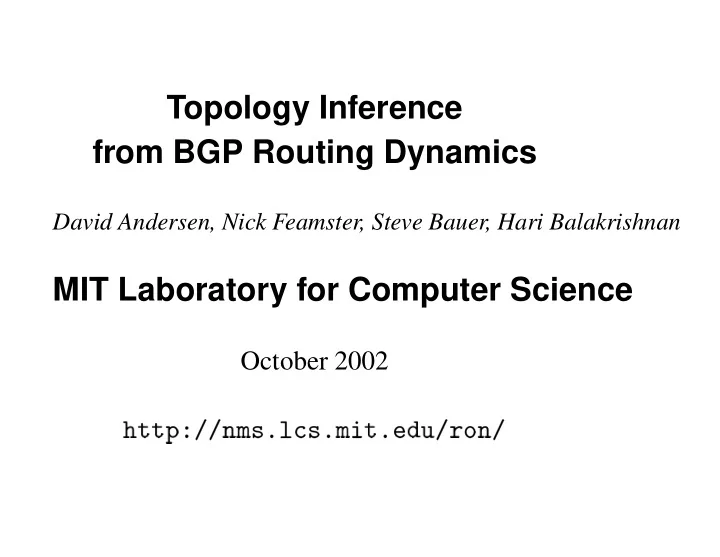

Topology Inference from BGP Routing Dynamics David Andersen, Nick Feamster, Steve Bauer, Hari Balakrishnan MIT Laboratory for Computer Science October 2002 http://nms.l s.mit.edu/ron/
Current Topologies: AS Topologies AT&T MIT BBN UUNET Sprint ✔ Simple to construct ✔ Completely passive - BGP snapshot ✘ Obnoxiously free of interesting detail
A few paths contain most prefixes 1 Fraction of announced prefixes 0.9 0.8 0.7 Source (AS) #prefixes 0.6 UUNET (701): 2053 0.5 REACH (1221): 1282 (hong Kong) AT&T (7018): 1250 0.4 UUNET (701 702): 1250 0.3 Supernet (3908): 793 0.2 0.1 Cumulative distribution 0 0 2000 4000 6000 8000 10000 14000 Number of origin AS’s � 13 common paths contain 10% of prefixes � Binning large ISPs misses critical detail
Current Topologies: Router-Level BBN2 UU−1 BBN1 mit1 mit2 BBN3 ATT−1 BBN4 ✔ Lots of juicy detail ✘ Requires active probing - Annoys the paranoid (and can be blocked) - Consumes time and bandwidth ➔ Best of both worlds?
New: Implied Logical Topologies Net 1 Net 2 Net 3 Net 4 � Group prefixes that “behave similarly” � What do the resulting clusters mean?
BGP update streams 2002-01-10 23:51:05 198.140.178.0/24 2002-01-10 23:51:05 192.107.237.0/24 2002-01-10 23:55:53 199.230.128.0/23 2002-01-10 23:56:21 216.9.174.0/23 2002-01-10 23:56:21 216.9.172.0/24 � Colored prefixes updated at (nearly) same time ➔ Cluster prefixes that often do this
Mechanics 2002-01-10 23:51:05 198.140.178.0/24 2002-01-10 23:51:05 192.107.237.0/24 2002-01-10 23:55:53 199.230.128.0/23 2002-01-10 23:56:21 216.9.174.0/23 2002-01-10 23:56:21 216.9.172.0/24 � Group by 30-second intervals (in practice, bin length choice flexible) (BGP min-route-adver time)
Creating BGP update vectors p1 updates (t) u 1 0 1 1 p1 p2 updates (t) 0 u 1 1 0 p2 time I seconds � Update stream is a 0/1 signal [ t; + 30 s ℄ ? Did an update happen in time t � Now we have a bunch of 0/1 vectors to compare...
BGP update vectors time � ! Prefix A 0 0 1 0 1 0 0 Prefix B 1 0 1 0 0 0 1 Prefix C 1 0 1 0 0 0 0 How close are two vectors? � Correlation coefficient
Correlation Coefficient A 0 0 1 0 1 0 0 B 1 0 1 0 0 0 1 C 1 0 1 0 0 0 0 [( p )( p )℄ E p p � � 1 1 2 2 ( p ) = corr ; p 1 2 � � p 1 p 2 � Expresses correlation well � Susceptable to some “coincidental” correlation
How to Group Prefixes? Input Distances Resulting Cluster A−B: 1 A−C: 0.75 B−C: 0.5 D−E: 0.25 E−A: 0.001 ... A B C D E Single-linkage clustering � Simple and efficient � Creates a similarty hierarchy: A & B most similar, etc.
How to Group Prefixes? Input Distances Resulting Cluster A−B: 1 A−C: 0.75 B−C: 0.5 D−E: 0.25 E−A: 0.001 ... A B C D E Single-linkage clustering � Simple and efficient � Creates a similarty hierarchy: A & B most similar, etc.
How to Group Prefixes? Input Distances Resulting Cluster A−B: 1 A−C: 0.75 B−C: 0.5 D−E: 0.25 E−A: 0.001 ... A B C D E Single-linkage clustering � Simple and efficient � Creates a similarty hierarchy: A & B most similar, etc.
How to Group Prefixes? Input Distances Resulting Cluster A−B: 1 A−C: 0.75 B−C: 0.5 D−E: 0.25 E−A: 0.001 ... A B C D E Single-linkage clustering � Simple and efficient � Creates a similarty hierarchy: A & B most similar, etc.
Data Capture and Analysis BBN AS 3 (MIT) Border Router Collection Host AS 10578 � Studied 90 days of BGP traffic at MIT � Examined 2 “huge” origin ASes – UUNET: 2338 prefixes – AT&T: 1310 prefixes � How do clusters relate to real-word features?
Anecdotes � Many “expected” results - same city, etc. We’ll get to those in a second. � 135.36.0.0/16, 135.12.0.0/14. Denver vs. New Jersey. Lucent vs. Agere – a spinoff in 2000, identical network behavior. (... CIA?) � 6 Sandia labs prefixes - internet2 routes, but flapped to backup UUNET route. � Many transient discoveries: backups, etc.
Topological similarities Measureable quantities: path, location � Compute pairwise similarity for metric (shared path length, or shared pop) � Average similarity as clustering proceeds � If match with logical clustering, similarity strongest for leaf clustering, weakest at end. ➔ Logical topology: integration of topological, organizational, and administrative factors.
Leaves share more hops in traceroute 22 20 Number of traceroute hops 18 16 14 12 10 UUNET max hops UUNET shared hops 8 2000 1500 1000 500 0 Number of clusters � Path length varies less with clustering � More shared hops in earlier clustering � Data noisy: loops, etc., but still works
Leaves often share the ISP POP 1 Avg. fraction of same-POP clustering 0.9 0.8 0.7 0.6 0.5 0.4 0.3 0.2 0.1 UUNET AT&T 0 2000 1500 1000 500 0 Number of clusters � UUNET: 50% clustered at 95% accuracy � AT&T: 30% clustered at 97% accuracy
What does it all mean? � Update clusters reflect reality: – Topology – Prefix assignment – Fate sharing � Passive window into remote networks � Facilitate network mapping and data collection � What else can be extracted from this signal? Similar signals?
Recommend
More recommend